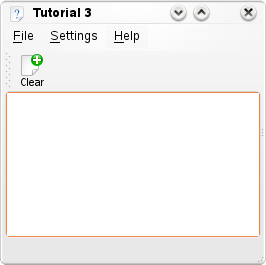Development/Tutorials/Using KActions: Difference between revisions
m Categorise |
m Authorship |
||
| Line 1: | Line 1: | ||
==Abstract== | ==Abstract== | ||
''Author'': [[User:Milliams|Matt Williams]] | |||
We're going to introduce the concept of actions. Actions are a unified way of supplying the user with ways to interact with your program. | We're going to introduce the concept of actions. Actions are a unified way of supplying the user with ways to interact with your program. | ||
Revision as of 01:02, 4 January 2007
Abstract
Author: Matt Williams
We're going to introduce the concept of actions. Actions are a unified way of supplying the user with ways to interact with your program.
Say, for example, we want to let the user clear the text box by clicking a button in the toolbar, from an option in the File menu or through a keyboard shortcut; we can provide all of those through one KAction.

Prerequisites
KAction
A KAction is an object which contains all the information about the icon and shortcuts you want associated to a certain action. You then connect the action to a slot which carries out the work of you action.
Creating Your Own
To create an action, you need to #include <KAction> in your .cpp file.
Creating the object
We're going to create an action which will clear the text area (see Tutorial 2). The KAction is built up in a number of steps. The first is creating the KAction
KAction* clearAction = new KAction(actionCollection(), "clear");
This creates a KAction called clearAction. The first constructor argument is telling the action that it is part of the KActionCollection actionCollection() and the second is simply setting a name for internal use (it doesn't necessarily have to be textually similar to the function of the action).
Text
Now we have out KAction object, we can start setting its properties. First, we'll set the text that will be displayed in the menu and under its icon in the toolbar.
clearAction->setText(i18n("Clear"));
As you can see, the text must be passed through the i18n() function if you want your UI to be translatable.
Icon
If you're going to display the action in a toolbar, you're going to want to have an icon depicting the action. To set an icon we simply use the setIcon() function thus:
clearAction->setIcon(KIcon("filenew"));
Here we're setting the icon to the standard KDE filenew icon.
Shortcut
We can also set a shortcut that will perform our action. It's as simple as a
clearAction->setShortcut(Qt::CTRL+Qt::Key_W);
to set Ctrl+W to be associated to this action.
Connecting the action
Now our action is fully set up, we need to connect it to something useful. We're going to connect our action to the clear() action belonging to a KTextArea.
connect(clearAction, SIGNAL(triggered(bool)), textArea, SLOT(clear()));
This is the came as it would be done in Qt with a QAction.
KStandardAction
For actions which would likely appear in almost every KDE application such as 'quit', 'save', and 'load' there are pre-created convenience KActions, accessed through KStandardAction.
They are very simple to use. Once you've done #include <KAction>, you simply need to supply it with what you want the function to do and which KActionCollection to add it to. For example,
KStandardAction::quit(kapp, SLOT(quit()), actionCollection());
Will Create a KAction with the correct icon, text and shortcut and will even add it to the File menu.
The Code
mainwindow.h
- ifndef MAINWINDOW_H
- define MAINWINDOW_H
- include <KMainWindow>
- include <KTextEdit>
class MainWindow : public KMainWindow
{
public:
MainWindow(QWidget *parent=0);
private:
KTextEdit* textArea;
void setupActions();
};
- endif
mainwindow.cpp
- include "mainwindow.h"
- include <KApplication>
- include <KAction>
- include <KStandardAction>
MainWindow::MainWindow(QWidget *parent) : KMainWindow(parent)
{
textArea = new KTextEdit;
setCentralWidget(textArea);
setupActions();
}
void MainWindow::setupActions()
{
KAction* clearAction = new KAction(actionCollection(), "clear");
clearAction->setText(i18n("Clear"));
clearAction->setIcon(KIcon("filenew"));
clearAction->setShortcut(Qt::CTRL+Qt::Key_W);
connect(clearAction, SIGNAL(triggered(bool)),
textArea, SLOT(clear()));
KStandardAction::quit(kapp, SLOT(quit()), actionCollection());
setupGUI();
}
main.cpp
- include <KApplication>
- include <KAboutData>
- include <KCmdLineArgs>
- include "mainwindow.h"
int main (int argc, char *argv[])
{
KAboutData aboutData( "tutorial3", "Tutorial 3",
"1.0", "A simple text area using KAction etc.",
KAboutData::License_GPL, "(c) 2006" );
KCmdLineArgs::init( argc, argv, &aboutData );
KApplication app;
MainWindow* window = new MainWindow();
window->show();
return app.exec();
}
Now, at the moment, we've only created our new "Clear" action. It won't yet show up in the menus or in the toolbars. To tell the program where to put our actions (and to allow the end-user to move them around) we use an xml file.
XMLGUI
TODO: Pah, I'm getting tired. Can someone write a bit of an intro to XMLGUI (mentioning that it will be replaced by liveui), walk through what the code below means and mention the naming rules of the .xml file :)
tutorial3ui.rc
<!DOCTYPE kpartgui SYSTEM "kpartgui.dtd">
<kpartgui name="tutorial3" version="1">
<ToolBar name="mainToolBar" >
<text>Main Toolbar</text>
<Action name="clear" />
</ToolBar>
<MenuBar>
<Menu name="file" >
<text>&File</text>
<Action name="clear" />
</Menu>
</MenuBar>
</kpartgui>
CMake
Now that we're using XMLGUI, we need to put the tutorial3ui.rc somewhere where KDE can find it. This means we need to install our project somewhere.
CMakeLists.txt
PROJECT(tutorial3)
FIND_PACKAGE(KDE4 REQUIRED)
INCLUDE_DIRECTORIES( ${KDE4_INCLUDES} )
SET(tutorial3_SRCS
main.cpp
mainwindow.cpp
)
KDE4_ADD_EXECUTABLE(tutorial3 ${tutorial3_SRCS})
TARGET_LINK_LIBRARIES( tutorial3 ${KDE4_KDEUI_LIBS})
install(TARGETS tutorial3 DESTINATION ${BIN_INSTALL_DIR})
install( FILES tutorial3ui.rc DESTINATION ${DATA_INSTALL_DIR}/tutorial3 )
Make, Install And Run
If you don't have write access to where your KDE4 installation directory, you can install it to a folder in your home directory.
To tell CMake where to install the program, set the DCMAKE_INSTALL_PREFIX switch. So to install the program to the KDE directory, do
cmake . -DCMAKE_INSTALL_PREFIX=$KDEDIR make install tutorial3
Moving On
Now that we can make the GUI look like and do whatever we want, we can move on to storing application settings with KConfig XT.
